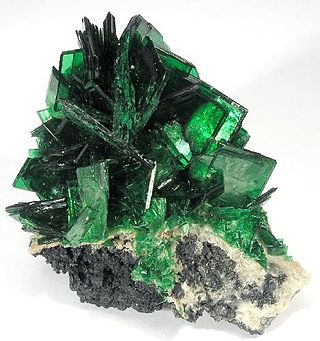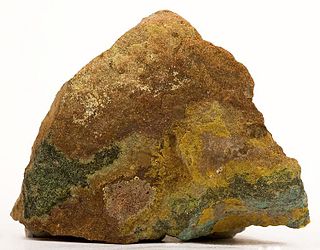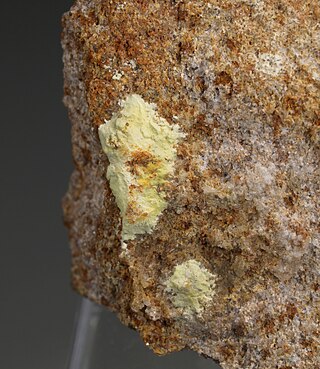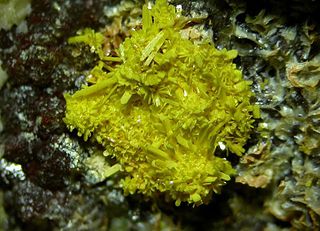
Torbernite, also known as chalcolite, is a relatively common mineral with the chemical formula Cu[(UO2)(PO4)]2(H2O)12. It is a radioactive, hydrated green copper uranyl phosphate, found in granites and other uranium-bearing deposits as a secondary mineral. The chemical formula of torbernite is similar to that of autunite in which a Cu2+ cation replaces a Ca2+ cation. Torbernite tends to dehydrate to metatorbernite with the sum formula Cu[(UO2)(PO4)]2(H2O)8.

Zippeite is a hydrous potassium uranium sulfate mineral with formula: K4(UO2)6(SO4)3(OH)10·4(H2O). It forms yellow to reddish brown monoclinic-prismatic crystals with perfect cleavage. The typical form is as encrustations and pulverulent earthy masses. It forms as efflorescent encrustations in underground uranium mines. It has a Mohs hardness of 2 and a specific gravity of 3.66. It is strongly fluorescent yellow under ultraviolet light and is moderately radioactive.

Uranopilite is a minor ore of uranium with the chemistry (UO2)6SO4(OH)6O2·14H2O or, hydrated uranyl sulfate hydroxide.

Schröckingerite is a radioactive yellow uranium-containing carbonate mineral, hydrated sodium calcium uranyl sulfate carbonate fluoride. Schröckingerite crystallizes in the orthorhombic system, occurring as globular clusters, and fluoresces yellow-green under ultraviolet light.

Coconinoite is a uranium ore that was discovered in Coconino County, Arizona. It is a phosphate mineral; or uranyl phosphate mineral along with other subclass uranium U6+ minerals like blatonite, boltwoodite, metazeunerite and rutherfordine.

Bergenite is a rare uranyl phosphate of the more specific phosphuranylite group. The phosphuranylite-type sheet in bergenite is a new isomer of the group, with the uranyl phosphate tetrahedra varying in an up-up-down, same-same-opposite (uuduudSSOSSO) orientation. All bergenite samples have been found in old mine dump sites. Uranyl minerals are a large constituent of uranium deposits.
Fermiite is a rare uranium mineral with the formula Na4(UO2)(SO4)3·3H2O. Chemically related minerals include oppenheimerite, meisserite (which is also structurally-related to fermiite), belakovskiite, natrozippeite and plášilite. Fermiite comes from the Blue Lizard mine, San Juan County, Utah, USA, which is known for many rare uranium minerals. The name honors Enrico Fermi (1901–1954).
Belakovskiite is a very rare uranium mineral with the formula Na7(UO2)(SO4)4(SO3OH)(H2O)3. It is interesting in being a natural uranyl salt with hydrosulfate anion, a feature shared with meisserite. Other chemically related minerals include fermiite, oppenheimerite, natrozippeite and plášilite. Most of these uranyl sulfate minerals was originally found in the Blue Lizard mine, San Juan County, Utah, US. The mineral is named after Russian mineralogist Dmitry Ilych Belakovskiy.
Oppenheimerite is a very rare uranium mineral with the formula Na2(UO2)(SO4)2•3H2O. Chemically related minerals include fermiite, natrozippeite, plášilite, belakovskiite and meisserite. Most of these uranyl sulfate minerals were originally found in the Blue Lizard mine, San Juan County, Utah, US. The mineral is named after American Theoretical physicist J. Robert Oppenheimer.
Plášilite is a very rare uranium mineral with the formula Na2(UO2)(SO4)2•3H2O. Chemically related minerals include natrozippeite, belakovskiite, meisserite, fermiite and oppenheimerite. Most of these uranyl sulfate minerals were originally found in the Blue Lizard mine, San Juan County, Utah, US. The mineral is named after Czech crystallographer Jakub Plášil.
Manganoblödite is a rare manganese mineral with the formula Na2Mn(SO4)2·4H2O. Somewhat chemically similar mineral is D'Ansite-(Mn). Manganoblödite was found in the Blue Lizard mine, San Juan County, Utah, US, which is known for several relatively new secondary uranium minerals In the mine, manganoblödite occurs intimately intergrown with manganese-, cobalt- and nickel-enriched blödite and a yet another new mineral - cobaltoblödite. Manganoblödite, as suggested by its name is a manganese-analogue of blödite. It is also analogous to changoite, cobaltoblödite and nickelblödite - all three are members of the blödite group.
Cobaltoblödite is a rare cobalt mineral with the formula Na2Co(SO4)2·4H2O. Cobaltoblödite was found in the Blue Lizard mine, San Juan County, Utah, USA, which is known for secondary uranium minerals. Cobaltoblödite occurs intimately intergrown with manganese-, cobalt- and nickel-enriched blödite and a yet another new mineral - manganoblödite. Cobaltoblödite, as suggested by its name is a cobalt-analogue of blödite. It is also analogous to changoite, manganoblödite and nickelblödite - other members of the blödite group.

Shumwayite is a rare but relatively simple uranyl sulfate mineral with the formula (UO2)2(SO4)2•5H2O. It was discovered in the Green Lizard and Giveaway-Simplot mines of the White Canyon mining district, San Juan County, Utah, US.
Plavnoite is a rare complex uranium sulfate mineral with the formula K0.8Mn0.6[(UO2)2O2(SO4)]•3.5H2O. Typically for the secondary uranium mineral, plavnoite contains uranyl groups. It was discovered in the Plavno mine in Jáchymov, Czech Republic. The Jáchymov site is known as a type locality for many rare and unique minerals.

Mathesiusite is a sulfate mineral containing potassium, vanadium, and uranium and has the chemical formula: K5(UO2)4(SO4)4(VO5)·4(H2O). It is a secondary mineral formed during post-mining processes.
Markeyite, a uranyl carbonate mineral discovered in the Markey Mine in Utah, USA. A group led by Anthony R. Kampf, a mineralogist at the Natural History Museum of Los Angeles County, USA discovered its structure.
Leószilárdite is a mineral discovered by Travis Olds of the University of Notre Dame and colleagues in the Markey Mine in Utah, USA. They named the mineral in honor of Leó Szilárd, Hungarian-born physicist and inventor. Leószilárdite is the first naturally occurring sodium- and magnesium-containing uranyl carbonate. It is rare and water-soluble, and was discovered on a seam of carbon-rich material deposited by an ancient stream. Groundwater reacted with the uraninite ore to create leószilárdite and other minerals.
Meyrowitzite, Ca(UO2)(CO3)2·5H2O, is a carbonate mineral verified in May of 2018 by the Commission of New Minerals, Nomenclature and Classification of the International Mineralogical Association. It is an extremely rare mineral, discovered in the Markey mine Utah, U.S.A. The mineral is a transparent yellow and has blades up to approximately 0.2 mm in length. It is soluble in water or aqueous solutions. Meyrowitzite is named in honor of Robert Meyrowitz (1916–2013), an American analytical chemist. After serving in WW II, he joined the United States Geological Survey (USGS). He was known for developing innovative new methods for analyzing small and difficult to study mineralogical samples along with his formulation of the high-index immersion liquids.
The sulfate fluorides are double salts that contain both sulfate and fluoride anions. They are in the class of mixed anion compounds. Some of these minerals are deposited in fumaroles.
Greenlizardite is a rare sulfate mineral discovered underground in the Green Lizard Mine, which the mineral was named for, in Utah. The mineral was found in mineralized ore channels within the Shinarump member of the Chinle formation. It occurs as a secondary alteration phase. It is associated with ammoniozippeite, boussingaultite, and dickite. Greenlizardite was approved as a mineral by the International Mineralogical Association in 2017.







